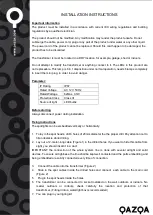
.
.
.
.
.
OMRON Scientific Technologies Inc
23
© OMRON STI 0613 PN99804-0060 Rev. B
8 S
AFE
M
OUNTING
D
ISTANCE
8
WARNING!
Never install an MS4800 system without
regard to the safety distance. If the MS4800 system is
mounted too close to the point of operation hazard, the
machine may not stop in time to prevent an operator injury.
An MS4800 system must be mounted far enough from the
machine danger zone so the machine will stop before a hand or
other body part reaches the hazardous area. This distance is
called the safety distance. It is a calculated number based on a
formula. See
Figure 8-1
for an illustration of the safety distance.
Regardless of the calculated distance, an MS4800 system should
never be mounted closer to the point of operation hazard than
specified by Table 0-10 in OSHA 1910.217.
Figure 8-1 Safe Mounting Distance
8 . 1 U S S
A F ET Y
D
I S T AN CE
F
OR MU L A S
In the United States two formulas exist to properly determine the safety distance. Omron STI
recommends the formula provided by the American National Standards Institute (ANSI) which
incorporates additional factors when compared to the formula required by OSHA.
The ANSI formula given below is for a normal approach to the light curtain.
D
s
= K x (T
s
+ T
c
+ T
r
+ T
bm
) + D
pf
Where:
D
s
=
minimum safety distance, in inches, between the MS4800 detection zone and the nearest point of
operation hazard.
K =
hand speed constant in inches per second. The ANSI standard value is 63 inches/second which
assumes the operator starts a hand motion toward the point of operation from rest. According to ANSI
B11.19-2003, the following factors should be considered when determining K:
a) Hand and arm movement
b) Twisting of the body or shoulder, or bending at the waist,
c) Walking or running.
One of the accepted values for
K
is the hand speed constant (it is usually considered as the horizontal
motion of the hand and arm while seated). Its common value is 63 in/s (1.6 m/s) although other values
(typically greater) are also used. The hand speed constant does not include other body movements,
which can affect the actual approach speed. Consideration of the above factors should be included
when determining the speed constant for a given application.
T
s
=
the stop time of the press (or machine) in seconds, measured from the final de-energized control
element. Measured at maximum closing velocity.
T
c
=
the response time, in seconds, of the press or machine control circuit to activate the machine’s
brake.
Light Curtain
D
s
Ds is the minimum safe distance
between the light curtain sensing
field and the point of operation
hazard (pinch point).
▲
!
▲
!
Buy: www.ValinOnline.com | Phone 844-385-3099 | Email: [email protected]
















































